Hospitality Report: Pacifica Restaurant's Gastronomy and NZ Cuisine
VerifiedAdded on 2023/03/30
|16
|4262
|243
Report
AI Summary
This report delves into the gastronomy of Pacifica Restaurant, a renowned establishment in New Zealand, examining its influence on the country's cuisine. It provides an executive summary and a table of contents, followed by an overview of the restaurant, emphasizing its focus on quality, fresh ingredients, and innovative dishes. The report then explores the background concept of gastronomy, tracing its origins and evolution, and analyzing the aspects of New Zealand cuisine, including the influences of various cultures and the significance of seafood. It also examines the New Zealand wine industry, discussing major wine-growing regions, grape varieties, and wine styles. The report further explores the meal experience and menu development at Pacifica Restaurant, highlighting its unique offerings and approach to gastronomy. Finally, it concludes with recommendations, referencing relevant literature throughout the analysis to provide a comprehensive understanding of the subject matter. This report contributes to the understanding of New Zealand's unique culinary landscape.

1
Pacifica
Name of the student
Name of the university
Author’s note
Pacifica
Name of the student
Name of the university
Author’s note
Paraphrase This Document
Need a fresh take? Get an instant paraphrase of this document with our AI Paraphraser
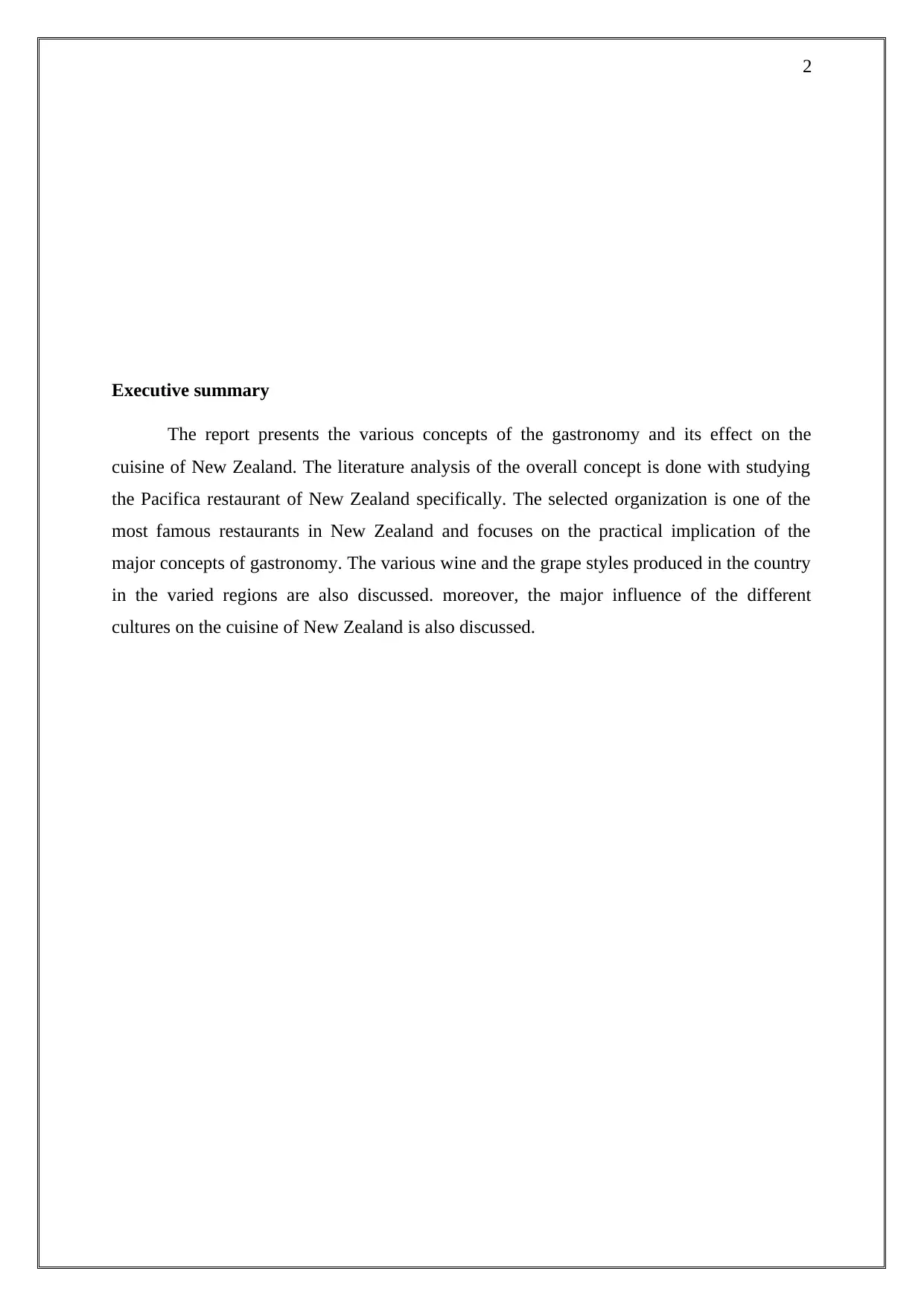
2
Executive summary
The report presents the various concepts of the gastronomy and its effect on the
cuisine of New Zealand. The literature analysis of the overall concept is done with studying
the Pacifica restaurant of New Zealand specifically. The selected organization is one of the
most famous restaurants in New Zealand and focuses on the practical implication of the
major concepts of gastronomy. The various wine and the grape styles produced in the country
in the varied regions are also discussed. moreover, the major influence of the different
cultures on the cuisine of New Zealand is also discussed.
Executive summary
The report presents the various concepts of the gastronomy and its effect on the
cuisine of New Zealand. The literature analysis of the overall concept is done with studying
the Pacifica restaurant of New Zealand specifically. The selected organization is one of the
most famous restaurants in New Zealand and focuses on the practical implication of the
major concepts of gastronomy. The various wine and the grape styles produced in the country
in the varied regions are also discussed. moreover, the major influence of the different
cultures on the cuisine of New Zealand is also discussed.
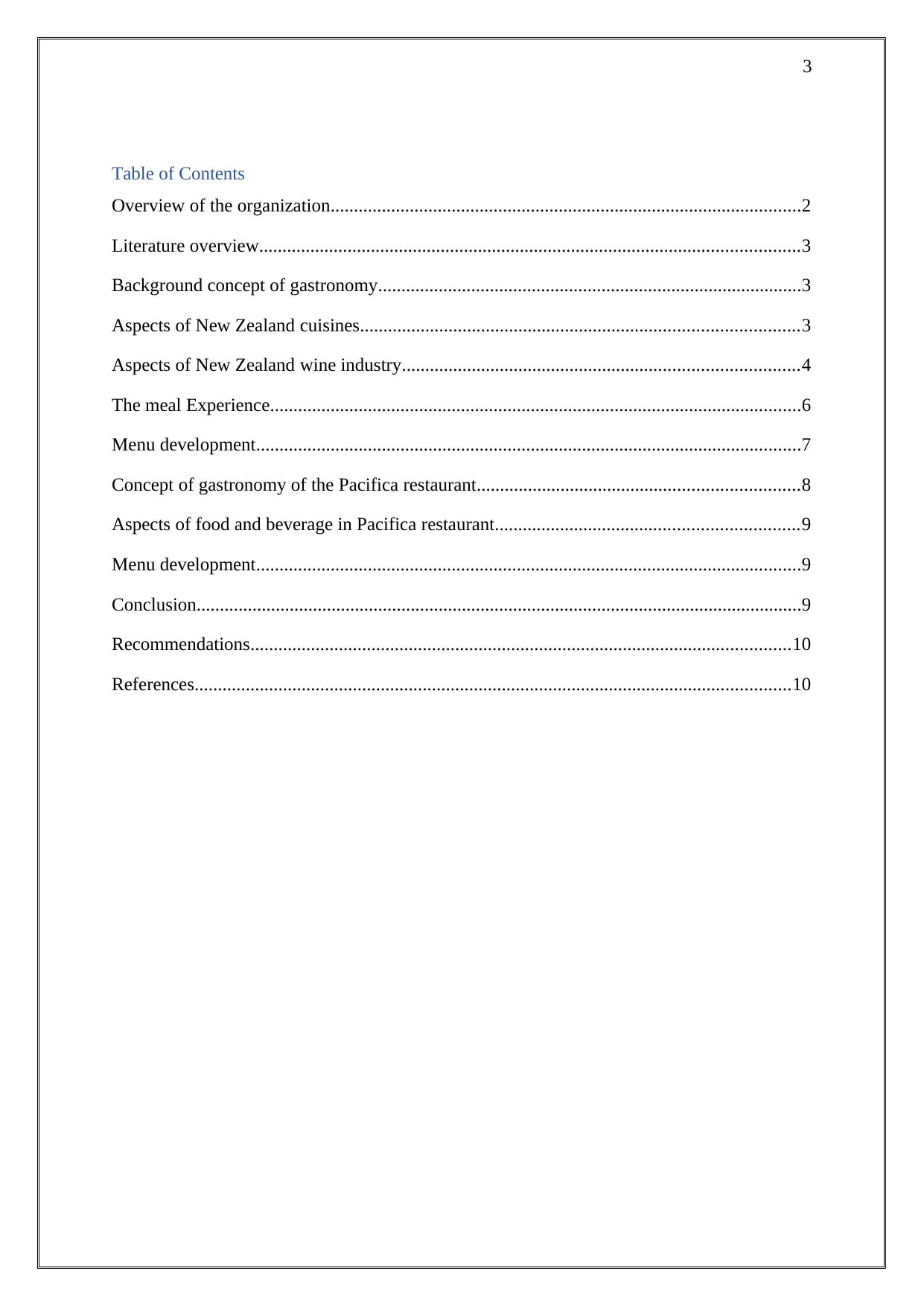
3
Table of Contents
Overview of the organization.....................................................................................................2
Literature overview....................................................................................................................3
Background concept of gastronomy...........................................................................................3
Aspects of New Zealand cuisines..............................................................................................3
Aspects of New Zealand wine industry.....................................................................................4
The meal Experience..................................................................................................................6
Menu development.....................................................................................................................7
Concept of gastronomy of the Pacifica restaurant.....................................................................8
Aspects of food and beverage in Pacifica restaurant.................................................................9
Menu development.....................................................................................................................9
Conclusion..................................................................................................................................9
Recommendations....................................................................................................................10
References................................................................................................................................10
Table of Contents
Overview of the organization.....................................................................................................2
Literature overview....................................................................................................................3
Background concept of gastronomy...........................................................................................3
Aspects of New Zealand cuisines..............................................................................................3
Aspects of New Zealand wine industry.....................................................................................4
The meal Experience..................................................................................................................6
Menu development.....................................................................................................................7
Concept of gastronomy of the Pacifica restaurant.....................................................................8
Aspects of food and beverage in Pacifica restaurant.................................................................9
Menu development.....................................................................................................................9
Conclusion..................................................................................................................................9
Recommendations....................................................................................................................10
References................................................................................................................................10
⊘ This is a preview!⊘
Do you want full access?
Subscribe today to unlock all pages.

Trusted by 1+ million students worldwide
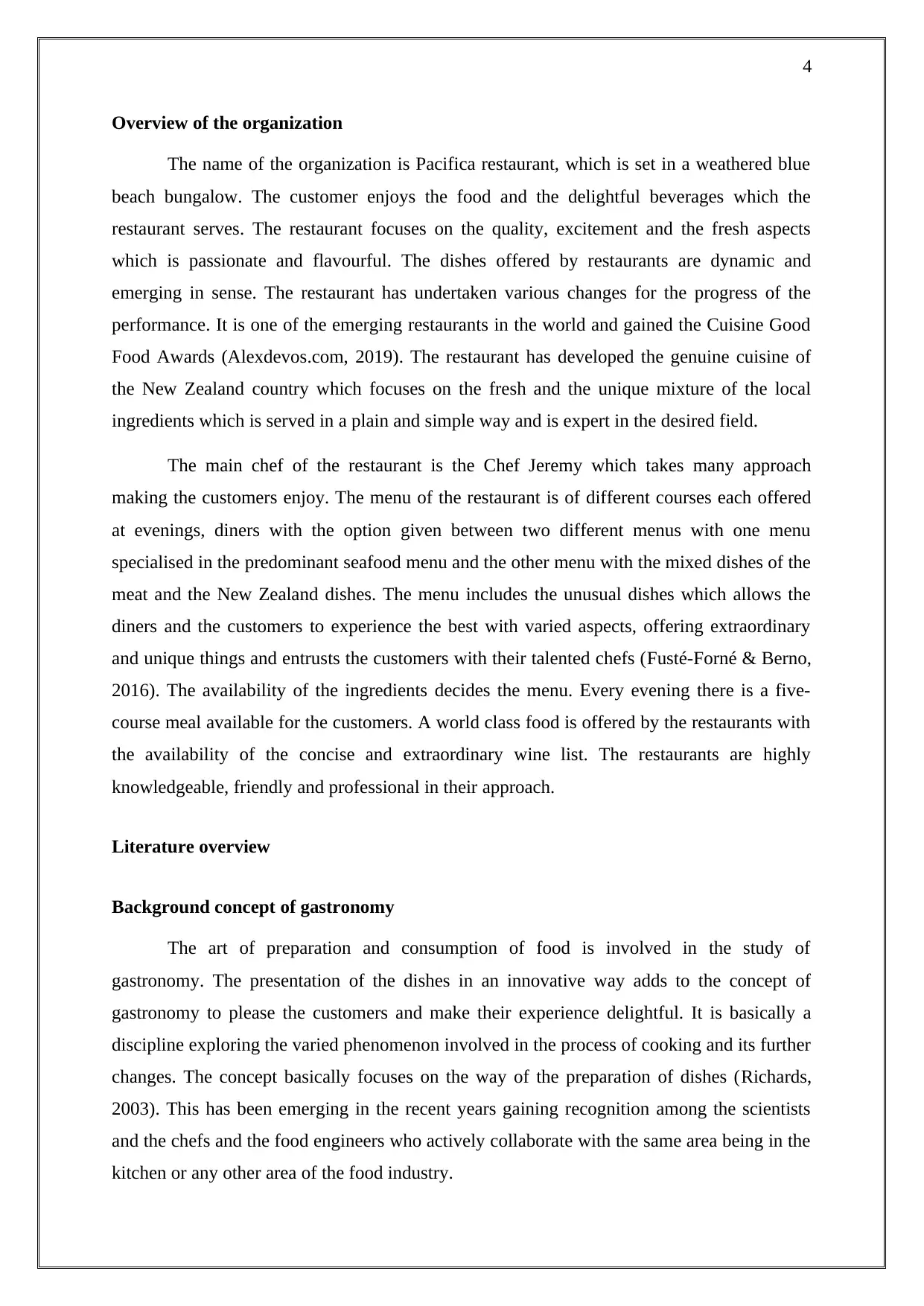
4
Overview of the organization
The name of the organization is Pacifica restaurant, which is set in a weathered blue
beach bungalow. The customer enjoys the food and the delightful beverages which the
restaurant serves. The restaurant focuses on the quality, excitement and the fresh aspects
which is passionate and flavourful. The dishes offered by restaurants are dynamic and
emerging in sense. The restaurant has undertaken various changes for the progress of the
performance. It is one of the emerging restaurants in the world and gained the Cuisine Good
Food Awards (Alexdevos.com, 2019). The restaurant has developed the genuine cuisine of
the New Zealand country which focuses on the fresh and the unique mixture of the local
ingredients which is served in a plain and simple way and is expert in the desired field.
The main chef of the restaurant is the Chef Jeremy which takes many approach
making the customers enjoy. The menu of the restaurant is of different courses each offered
at evenings, diners with the option given between two different menus with one menu
specialised in the predominant seafood menu and the other menu with the mixed dishes of the
meat and the New Zealand dishes. The menu includes the unusual dishes which allows the
diners and the customers to experience the best with varied aspects, offering extraordinary
and unique things and entrusts the customers with their talented chefs (Fusté-Forné & Berno,
2016). The availability of the ingredients decides the menu. Every evening there is a five-
course meal available for the customers. A world class food is offered by the restaurants with
the availability of the concise and extraordinary wine list. The restaurants are highly
knowledgeable, friendly and professional in their approach.
Literature overview
Background concept of gastronomy
The art of preparation and consumption of food is involved in the study of
gastronomy. The presentation of the dishes in an innovative way adds to the concept of
gastronomy to please the customers and make their experience delightful. It is basically a
discipline exploring the varied phenomenon involved in the process of cooking and its further
changes. The concept basically focuses on the way of the preparation of dishes (Richards,
2003). This has been emerging in the recent years gaining recognition among the scientists
and the chefs and the food engineers who actively collaborate with the same area being in the
kitchen or any other area of the food industry.
Overview of the organization
The name of the organization is Pacifica restaurant, which is set in a weathered blue
beach bungalow. The customer enjoys the food and the delightful beverages which the
restaurant serves. The restaurant focuses on the quality, excitement and the fresh aspects
which is passionate and flavourful. The dishes offered by restaurants are dynamic and
emerging in sense. The restaurant has undertaken various changes for the progress of the
performance. It is one of the emerging restaurants in the world and gained the Cuisine Good
Food Awards (Alexdevos.com, 2019). The restaurant has developed the genuine cuisine of
the New Zealand country which focuses on the fresh and the unique mixture of the local
ingredients which is served in a plain and simple way and is expert in the desired field.
The main chef of the restaurant is the Chef Jeremy which takes many approach
making the customers enjoy. The menu of the restaurant is of different courses each offered
at evenings, diners with the option given between two different menus with one menu
specialised in the predominant seafood menu and the other menu with the mixed dishes of the
meat and the New Zealand dishes. The menu includes the unusual dishes which allows the
diners and the customers to experience the best with varied aspects, offering extraordinary
and unique things and entrusts the customers with their talented chefs (Fusté-Forné & Berno,
2016). The availability of the ingredients decides the menu. Every evening there is a five-
course meal available for the customers. A world class food is offered by the restaurants with
the availability of the concise and extraordinary wine list. The restaurants are highly
knowledgeable, friendly and professional in their approach.
Literature overview
Background concept of gastronomy
The art of preparation and consumption of food is involved in the study of
gastronomy. The presentation of the dishes in an innovative way adds to the concept of
gastronomy to please the customers and make their experience delightful. It is basically a
discipline exploring the varied phenomenon involved in the process of cooking and its further
changes. The concept basically focuses on the way of the preparation of dishes (Richards,
2003). This has been emerging in the recent years gaining recognition among the scientists
and the chefs and the food engineers who actively collaborate with the same area being in the
kitchen or any other area of the food industry.
Paraphrase This Document
Need a fresh take? Get an instant paraphrase of this document with our AI Paraphraser
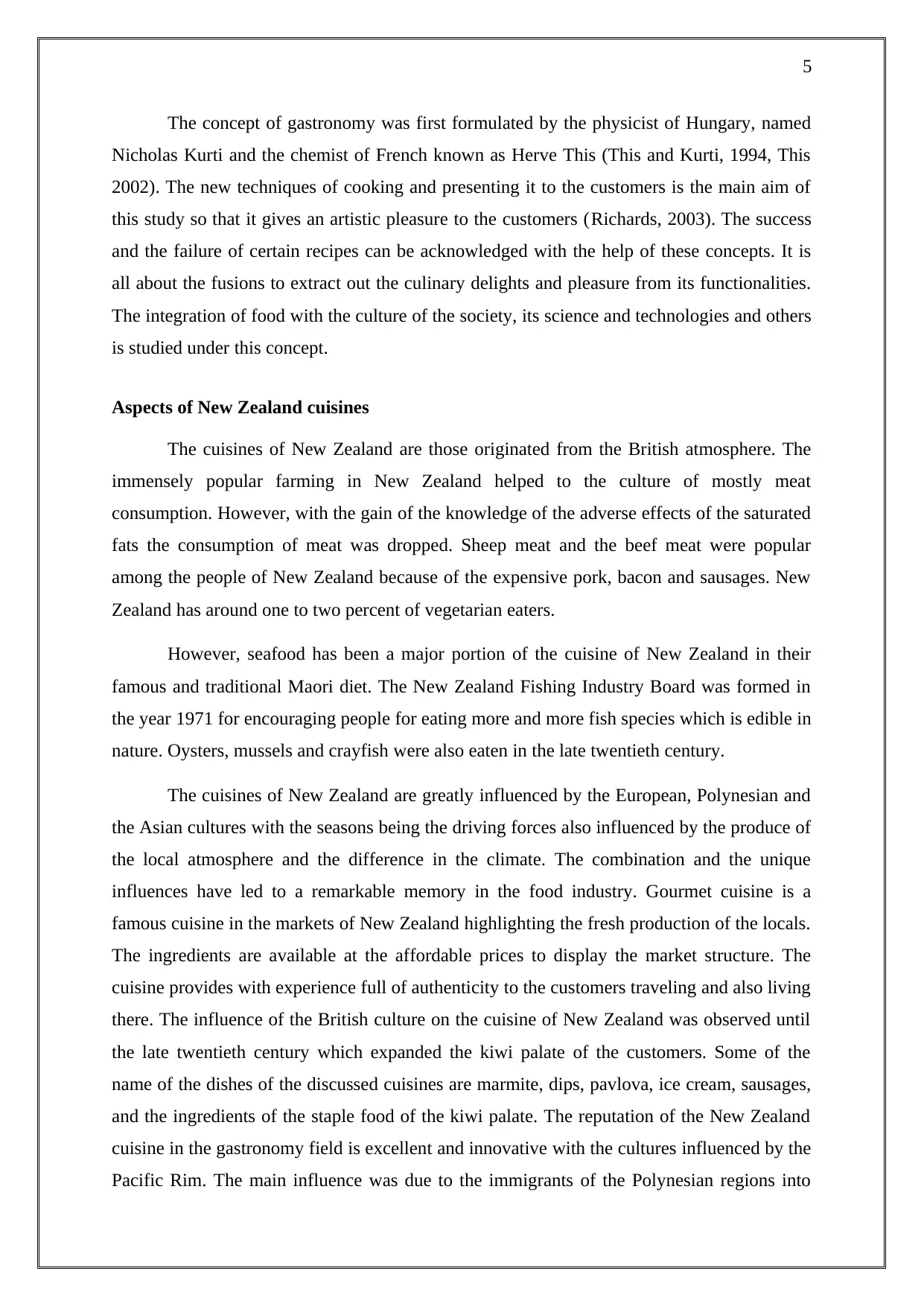
5
The concept of gastronomy was first formulated by the physicist of Hungary, named
Nicholas Kurti and the chemist of French known as Herve This (This and Kurti, 1994, This
2002). The new techniques of cooking and presenting it to the customers is the main aim of
this study so that it gives an artistic pleasure to the customers (Richards, 2003). The success
and the failure of certain recipes can be acknowledged with the help of these concepts. It is
all about the fusions to extract out the culinary delights and pleasure from its functionalities.
The integration of food with the culture of the society, its science and technologies and others
is studied under this concept.
Aspects of New Zealand cuisines
The cuisines of New Zealand are those originated from the British atmosphere. The
immensely popular farming in New Zealand helped to the culture of mostly meat
consumption. However, with the gain of the knowledge of the adverse effects of the saturated
fats the consumption of meat was dropped. Sheep meat and the beef meat were popular
among the people of New Zealand because of the expensive pork, bacon and sausages. New
Zealand has around one to two percent of vegetarian eaters.
However, seafood has been a major portion of the cuisine of New Zealand in their
famous and traditional Maori diet. The New Zealand Fishing Industry Board was formed in
the year 1971 for encouraging people for eating more and more fish species which is edible in
nature. Oysters, mussels and crayfish were also eaten in the late twentieth century.
The cuisines of New Zealand are greatly influenced by the European, Polynesian and
the Asian cultures with the seasons being the driving forces also influenced by the produce of
the local atmosphere and the difference in the climate. The combination and the unique
influences have led to a remarkable memory in the food industry. Gourmet cuisine is a
famous cuisine in the markets of New Zealand highlighting the fresh production of the locals.
The ingredients are available at the affordable prices to display the market structure. The
cuisine provides with experience full of authenticity to the customers traveling and also living
there. The influence of the British culture on the cuisine of New Zealand was observed until
the late twentieth century which expanded the kiwi palate of the customers. Some of the
name of the dishes of the discussed cuisines are marmite, dips, pavlova, ice cream, sausages,
and the ingredients of the staple food of the kiwi palate. The reputation of the New Zealand
cuisine in the gastronomy field is excellent and innovative with the cultures influenced by the
Pacific Rim. The main influence was due to the immigrants of the Polynesian regions into
The concept of gastronomy was first formulated by the physicist of Hungary, named
Nicholas Kurti and the chemist of French known as Herve This (This and Kurti, 1994, This
2002). The new techniques of cooking and presenting it to the customers is the main aim of
this study so that it gives an artistic pleasure to the customers (Richards, 2003). The success
and the failure of certain recipes can be acknowledged with the help of these concepts. It is
all about the fusions to extract out the culinary delights and pleasure from its functionalities.
The integration of food with the culture of the society, its science and technologies and others
is studied under this concept.
Aspects of New Zealand cuisines
The cuisines of New Zealand are those originated from the British atmosphere. The
immensely popular farming in New Zealand helped to the culture of mostly meat
consumption. However, with the gain of the knowledge of the adverse effects of the saturated
fats the consumption of meat was dropped. Sheep meat and the beef meat were popular
among the people of New Zealand because of the expensive pork, bacon and sausages. New
Zealand has around one to two percent of vegetarian eaters.
However, seafood has been a major portion of the cuisine of New Zealand in their
famous and traditional Maori diet. The New Zealand Fishing Industry Board was formed in
the year 1971 for encouraging people for eating more and more fish species which is edible in
nature. Oysters, mussels and crayfish were also eaten in the late twentieth century.
The cuisines of New Zealand are greatly influenced by the European, Polynesian and
the Asian cultures with the seasons being the driving forces also influenced by the produce of
the local atmosphere and the difference in the climate. The combination and the unique
influences have led to a remarkable memory in the food industry. Gourmet cuisine is a
famous cuisine in the markets of New Zealand highlighting the fresh production of the locals.
The ingredients are available at the affordable prices to display the market structure. The
cuisine provides with experience full of authenticity to the customers traveling and also living
there. The influence of the British culture on the cuisine of New Zealand was observed until
the late twentieth century which expanded the kiwi palate of the customers. Some of the
name of the dishes of the discussed cuisines are marmite, dips, pavlova, ice cream, sausages,
and the ingredients of the staple food of the kiwi palate. The reputation of the New Zealand
cuisine in the gastronomy field is excellent and innovative with the cultures influenced by the
Pacific Rim. The main influence was due to the immigrants of the Polynesian regions into
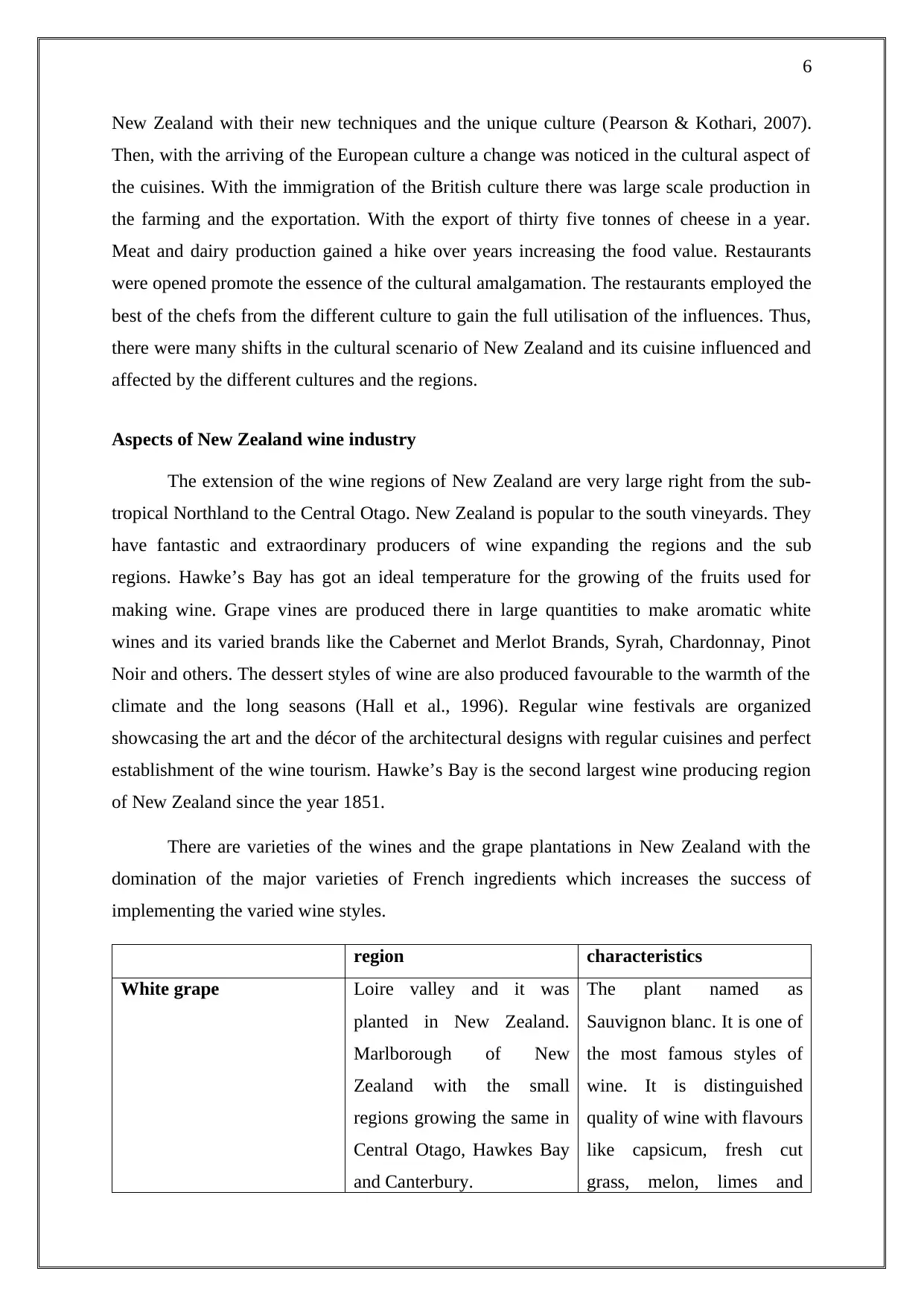
6
New Zealand with their new techniques and the unique culture (Pearson & Kothari, 2007).
Then, with the arriving of the European culture a change was noticed in the cultural aspect of
the cuisines. With the immigration of the British culture there was large scale production in
the farming and the exportation. With the export of thirty five tonnes of cheese in a year.
Meat and dairy production gained a hike over years increasing the food value. Restaurants
were opened promote the essence of the cultural amalgamation. The restaurants employed the
best of the chefs from the different culture to gain the full utilisation of the influences. Thus,
there were many shifts in the cultural scenario of New Zealand and its cuisine influenced and
affected by the different cultures and the regions.
Aspects of New Zealand wine industry
The extension of the wine regions of New Zealand are very large right from the sub-
tropical Northland to the Central Otago. New Zealand is popular to the south vineyards. They
have fantastic and extraordinary producers of wine expanding the regions and the sub
regions. Hawke’s Bay has got an ideal temperature for the growing of the fruits used for
making wine. Grape vines are produced there in large quantities to make aromatic white
wines and its varied brands like the Cabernet and Merlot Brands, Syrah, Chardonnay, Pinot
Noir and others. The dessert styles of wine are also produced favourable to the warmth of the
climate and the long seasons (Hall et al., 1996). Regular wine festivals are organized
showcasing the art and the décor of the architectural designs with regular cuisines and perfect
establishment of the wine tourism. Hawke’s Bay is the second largest wine producing region
of New Zealand since the year 1851.
There are varieties of the wines and the grape plantations in New Zealand with the
domination of the major varieties of French ingredients which increases the success of
implementing the varied wine styles.
region characteristics
White grape Loire valley and it was
planted in New Zealand.
Marlborough of New
Zealand with the small
regions growing the same in
Central Otago, Hawkes Bay
and Canterbury.
The plant named as
Sauvignon blanc. It is one of
the most famous styles of
wine. It is distinguished
quality of wine with flavours
like capsicum, fresh cut
grass, melon, limes and
New Zealand with their new techniques and the unique culture (Pearson & Kothari, 2007).
Then, with the arriving of the European culture a change was noticed in the cultural aspect of
the cuisines. With the immigration of the British culture there was large scale production in
the farming and the exportation. With the export of thirty five tonnes of cheese in a year.
Meat and dairy production gained a hike over years increasing the food value. Restaurants
were opened promote the essence of the cultural amalgamation. The restaurants employed the
best of the chefs from the different culture to gain the full utilisation of the influences. Thus,
there were many shifts in the cultural scenario of New Zealand and its cuisine influenced and
affected by the different cultures and the regions.
Aspects of New Zealand wine industry
The extension of the wine regions of New Zealand are very large right from the sub-
tropical Northland to the Central Otago. New Zealand is popular to the south vineyards. They
have fantastic and extraordinary producers of wine expanding the regions and the sub
regions. Hawke’s Bay has got an ideal temperature for the growing of the fruits used for
making wine. Grape vines are produced there in large quantities to make aromatic white
wines and its varied brands like the Cabernet and Merlot Brands, Syrah, Chardonnay, Pinot
Noir and others. The dessert styles of wine are also produced favourable to the warmth of the
climate and the long seasons (Hall et al., 1996). Regular wine festivals are organized
showcasing the art and the décor of the architectural designs with regular cuisines and perfect
establishment of the wine tourism. Hawke’s Bay is the second largest wine producing region
of New Zealand since the year 1851.
There are varieties of the wines and the grape plantations in New Zealand with the
domination of the major varieties of French ingredients which increases the success of
implementing the varied wine styles.
region characteristics
White grape Loire valley and it was
planted in New Zealand.
Marlborough of New
Zealand with the small
regions growing the same in
Central Otago, Hawkes Bay
and Canterbury.
The plant named as
Sauvignon blanc. It is one of
the most famous styles of
wine. It is distinguished
quality of wine with flavours
like capsicum, fresh cut
grass, melon, limes and
⊘ This is a preview!⊘
Do you want full access?
Subscribe today to unlock all pages.

Trusted by 1+ million students worldwide
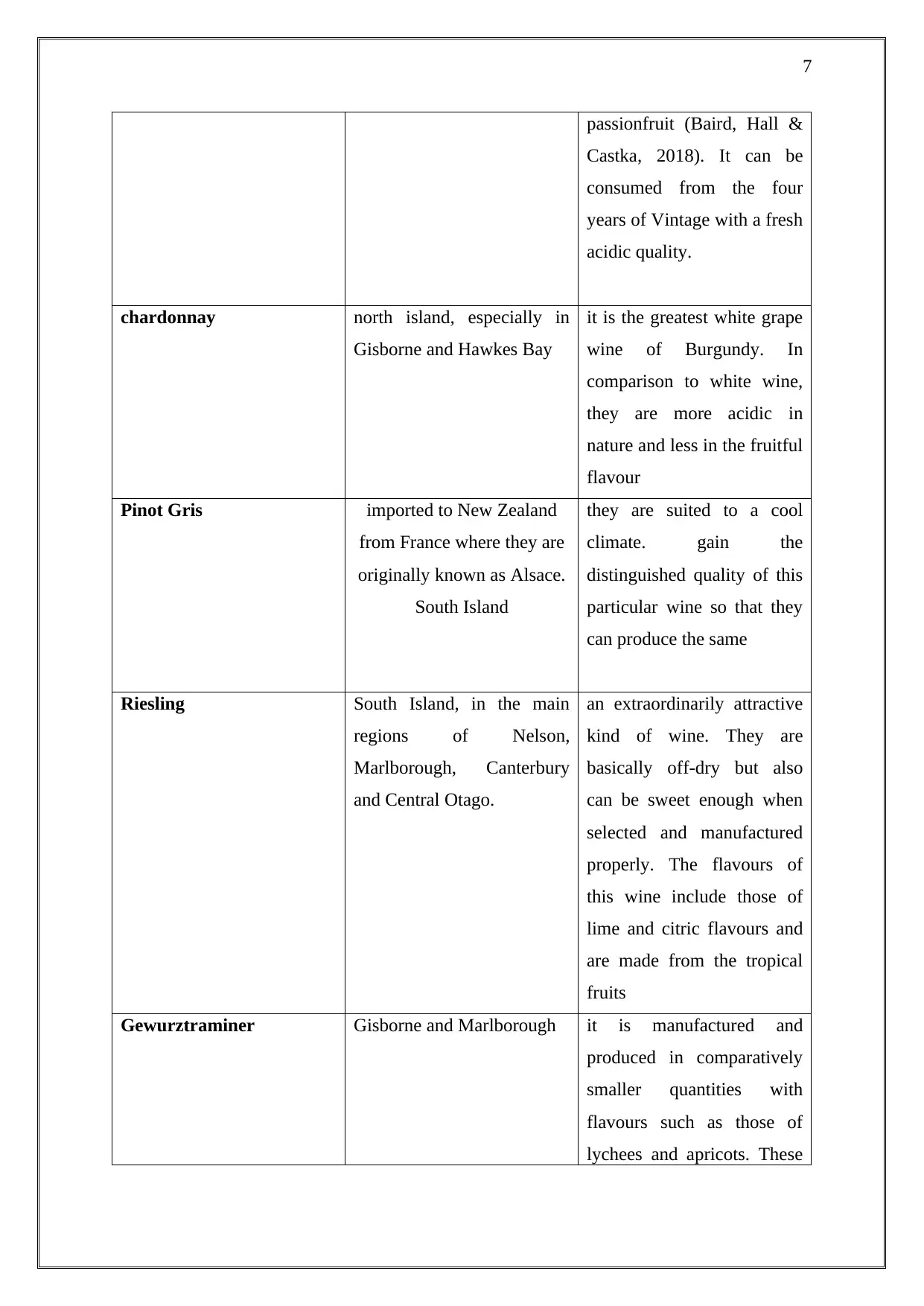
7
passionfruit (Baird, Hall &
Castka, 2018). It can be
consumed from the four
years of Vintage with a fresh
acidic quality.
chardonnay north island, especially in
Gisborne and Hawkes Bay
it is the greatest white grape
wine of Burgundy. In
comparison to white wine,
they are more acidic in
nature and less in the fruitful
flavour
Pinot Gris imported to New Zealand
from France where they are
originally known as Alsace.
South Island
they are suited to a cool
climate. gain the
distinguished quality of this
particular wine so that they
can produce the same
Riesling South Island, in the main
regions of Nelson,
Marlborough, Canterbury
and Central Otago.
an extraordinarily attractive
kind of wine. They are
basically off-dry but also
can be sweet enough when
selected and manufactured
properly. The flavours of
this wine include those of
lime and citric flavours and
are made from the tropical
fruits
Gewurztraminer Gisborne and Marlborough it is manufactured and
produced in comparatively
smaller quantities with
flavours such as those of
lychees and apricots. These
passionfruit (Baird, Hall &
Castka, 2018). It can be
consumed from the four
years of Vintage with a fresh
acidic quality.
chardonnay north island, especially in
Gisborne and Hawkes Bay
it is the greatest white grape
wine of Burgundy. In
comparison to white wine,
they are more acidic in
nature and less in the fruitful
flavour
Pinot Gris imported to New Zealand
from France where they are
originally known as Alsace.
South Island
they are suited to a cool
climate. gain the
distinguished quality of this
particular wine so that they
can produce the same
Riesling South Island, in the main
regions of Nelson,
Marlborough, Canterbury
and Central Otago.
an extraordinarily attractive
kind of wine. They are
basically off-dry but also
can be sweet enough when
selected and manufactured
properly. The flavours of
this wine include those of
lime and citric flavours and
are made from the tropical
fruits
Gewurztraminer Gisborne and Marlborough it is manufactured and
produced in comparatively
smaller quantities with
flavours such as those of
lychees and apricots. These
Paraphrase This Document
Need a fresh take? Get an instant paraphrase of this document with our AI Paraphraser
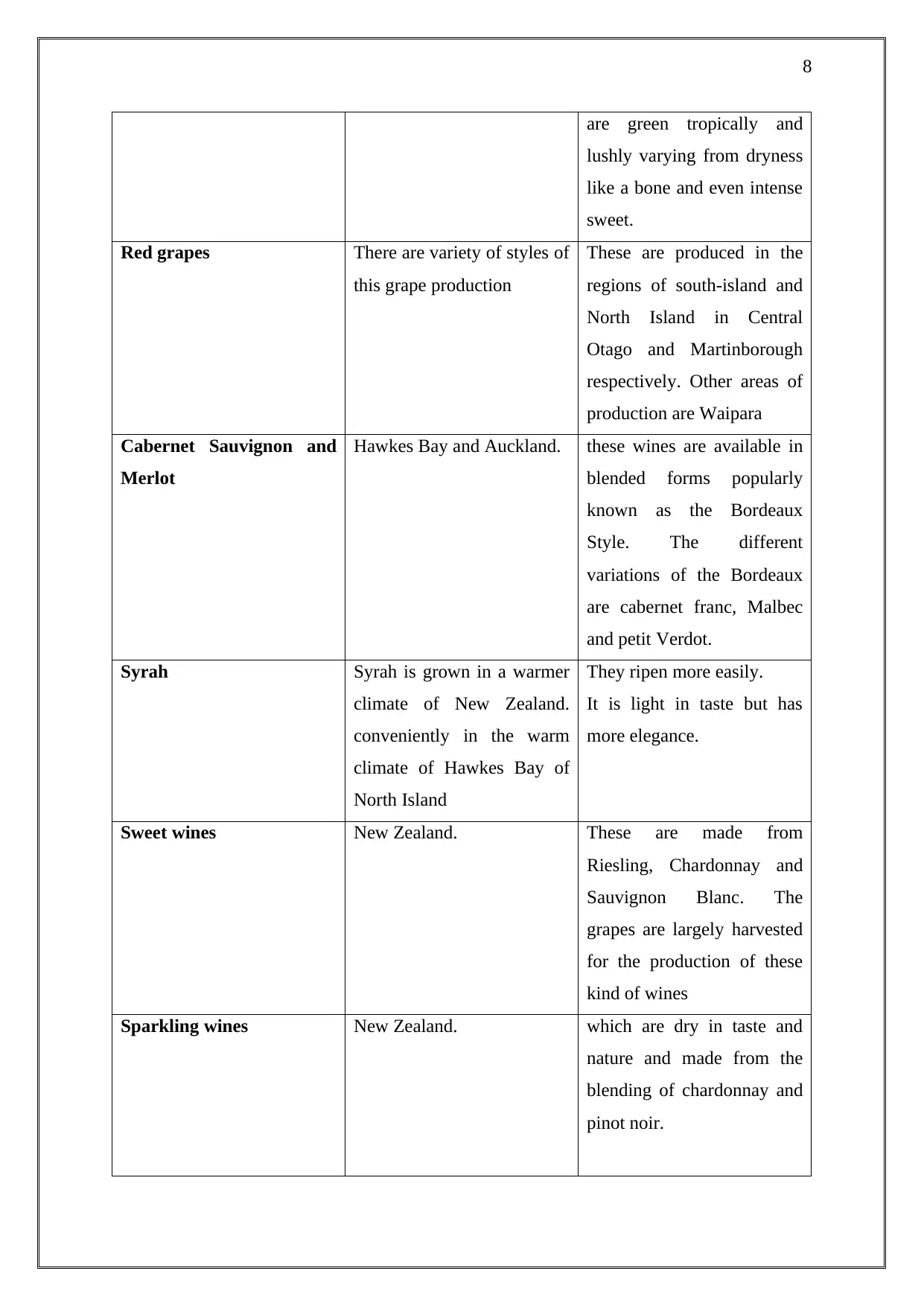
8
are green tropically and
lushly varying from dryness
like a bone and even intense
sweet.
Red grapes There are variety of styles of
this grape production
These are produced in the
regions of south-island and
North Island in Central
Otago and Martinborough
respectively. Other areas of
production are Waipara
Cabernet Sauvignon and
Merlot
Hawkes Bay and Auckland. these wines are available in
blended forms popularly
known as the Bordeaux
Style. The different
variations of the Bordeaux
are cabernet franc, Malbec
and petit Verdot.
Syrah Syrah is grown in a warmer
climate of New Zealand.
conveniently in the warm
climate of Hawkes Bay of
North Island
They ripen more easily.
It is light in taste but has
more elegance.
Sweet wines New Zealand. These are made from
Riesling, Chardonnay and
Sauvignon Blanc. The
grapes are largely harvested
for the production of these
kind of wines
Sparkling wines New Zealand. which are dry in taste and
nature and made from the
blending of chardonnay and
pinot noir.
are green tropically and
lushly varying from dryness
like a bone and even intense
sweet.
Red grapes There are variety of styles of
this grape production
These are produced in the
regions of south-island and
North Island in Central
Otago and Martinborough
respectively. Other areas of
production are Waipara
Cabernet Sauvignon and
Merlot
Hawkes Bay and Auckland. these wines are available in
blended forms popularly
known as the Bordeaux
Style. The different
variations of the Bordeaux
are cabernet franc, Malbec
and petit Verdot.
Syrah Syrah is grown in a warmer
climate of New Zealand.
conveniently in the warm
climate of Hawkes Bay of
North Island
They ripen more easily.
It is light in taste but has
more elegance.
Sweet wines New Zealand. These are made from
Riesling, Chardonnay and
Sauvignon Blanc. The
grapes are largely harvested
for the production of these
kind of wines
Sparkling wines New Zealand. which are dry in taste and
nature and made from the
blending of chardonnay and
pinot noir.
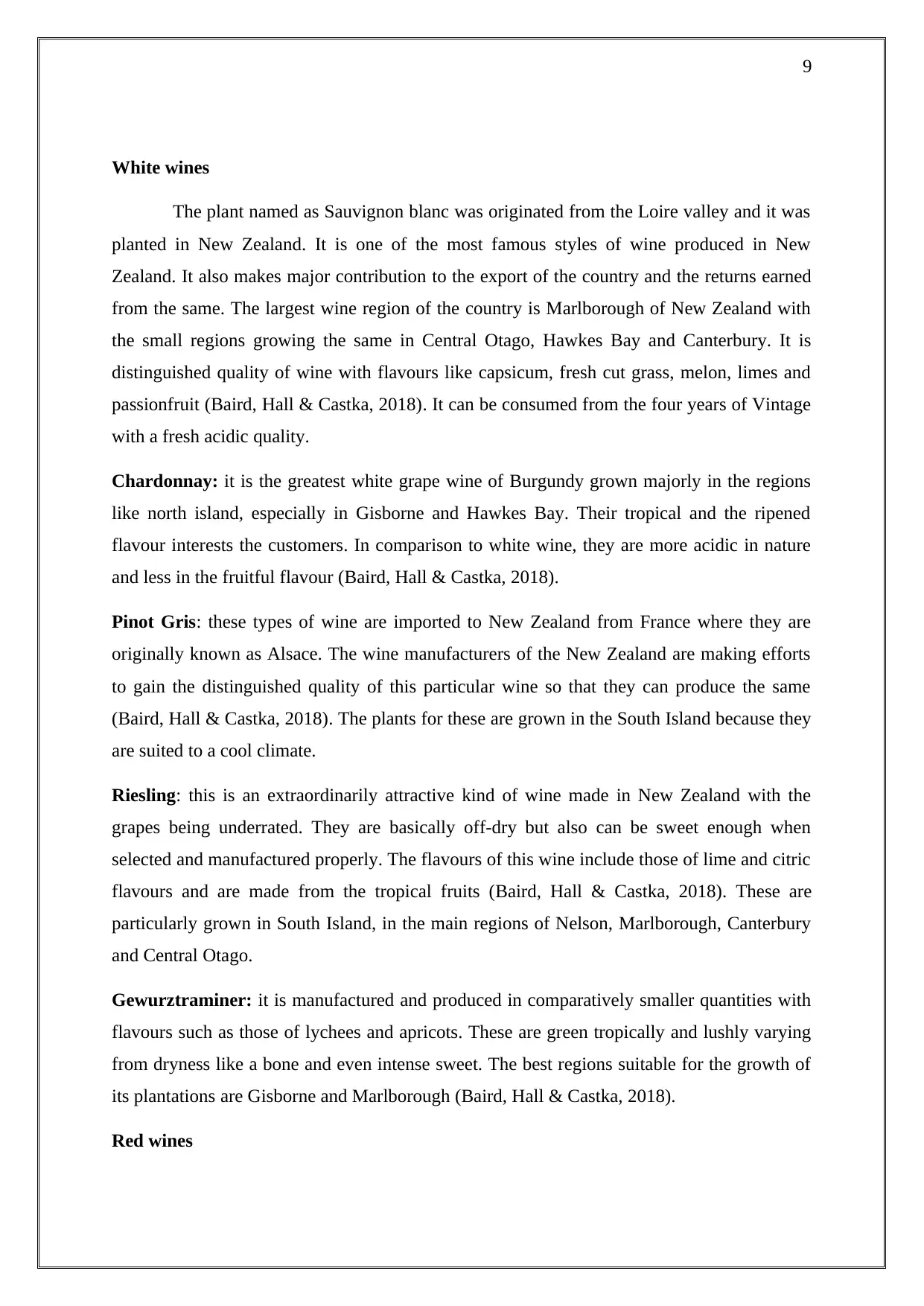
9
White wines
The plant named as Sauvignon blanc was originated from the Loire valley and it was
planted in New Zealand. It is one of the most famous styles of wine produced in New
Zealand. It also makes major contribution to the export of the country and the returns earned
from the same. The largest wine region of the country is Marlborough of New Zealand with
the small regions growing the same in Central Otago, Hawkes Bay and Canterbury. It is
distinguished quality of wine with flavours like capsicum, fresh cut grass, melon, limes and
passionfruit (Baird, Hall & Castka, 2018). It can be consumed from the four years of Vintage
with a fresh acidic quality.
Chardonnay: it is the greatest white grape wine of Burgundy grown majorly in the regions
like north island, especially in Gisborne and Hawkes Bay. Their tropical and the ripened
flavour interests the customers. In comparison to white wine, they are more acidic in nature
and less in the fruitful flavour (Baird, Hall & Castka, 2018).
Pinot Gris: these types of wine are imported to New Zealand from France where they are
originally known as Alsace. The wine manufacturers of the New Zealand are making efforts
to gain the distinguished quality of this particular wine so that they can produce the same
(Baird, Hall & Castka, 2018). The plants for these are grown in the South Island because they
are suited to a cool climate.
Riesling: this is an extraordinarily attractive kind of wine made in New Zealand with the
grapes being underrated. They are basically off-dry but also can be sweet enough when
selected and manufactured properly. The flavours of this wine include those of lime and citric
flavours and are made from the tropical fruits (Baird, Hall & Castka, 2018). These are
particularly grown in South Island, in the main regions of Nelson, Marlborough, Canterbury
and Central Otago.
Gewurztraminer: it is manufactured and produced in comparatively smaller quantities with
flavours such as those of lychees and apricots. These are green tropically and lushly varying
from dryness like a bone and even intense sweet. The best regions suitable for the growth of
its plantations are Gisborne and Marlborough (Baird, Hall & Castka, 2018).
Red wines
White wines
The plant named as Sauvignon blanc was originated from the Loire valley and it was
planted in New Zealand. It is one of the most famous styles of wine produced in New
Zealand. It also makes major contribution to the export of the country and the returns earned
from the same. The largest wine region of the country is Marlborough of New Zealand with
the small regions growing the same in Central Otago, Hawkes Bay and Canterbury. It is
distinguished quality of wine with flavours like capsicum, fresh cut grass, melon, limes and
passionfruit (Baird, Hall & Castka, 2018). It can be consumed from the four years of Vintage
with a fresh acidic quality.
Chardonnay: it is the greatest white grape wine of Burgundy grown majorly in the regions
like north island, especially in Gisborne and Hawkes Bay. Their tropical and the ripened
flavour interests the customers. In comparison to white wine, they are more acidic in nature
and less in the fruitful flavour (Baird, Hall & Castka, 2018).
Pinot Gris: these types of wine are imported to New Zealand from France where they are
originally known as Alsace. The wine manufacturers of the New Zealand are making efforts
to gain the distinguished quality of this particular wine so that they can produce the same
(Baird, Hall & Castka, 2018). The plants for these are grown in the South Island because they
are suited to a cool climate.
Riesling: this is an extraordinarily attractive kind of wine made in New Zealand with the
grapes being underrated. They are basically off-dry but also can be sweet enough when
selected and manufactured properly. The flavours of this wine include those of lime and citric
flavours and are made from the tropical fruits (Baird, Hall & Castka, 2018). These are
particularly grown in South Island, in the main regions of Nelson, Marlborough, Canterbury
and Central Otago.
Gewurztraminer: it is manufactured and produced in comparatively smaller quantities with
flavours such as those of lychees and apricots. These are green tropically and lushly varying
from dryness like a bone and even intense sweet. The best regions suitable for the growth of
its plantations are Gisborne and Marlborough (Baird, Hall & Castka, 2018).
Red wines
⊘ This is a preview!⊘
Do you want full access?
Subscribe today to unlock all pages.

Trusted by 1+ million students worldwide
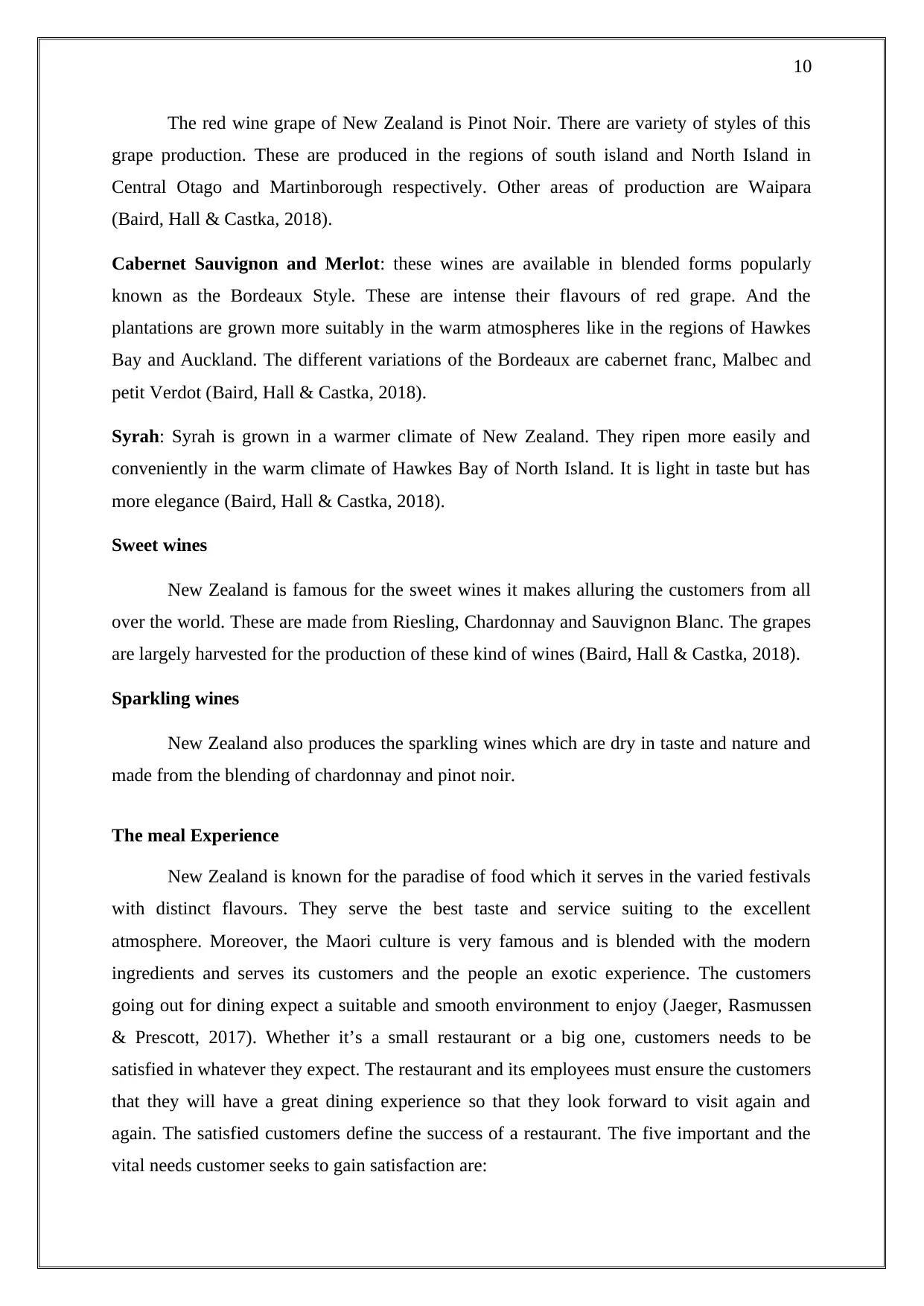
10
The red wine grape of New Zealand is Pinot Noir. There are variety of styles of this
grape production. These are produced in the regions of south island and North Island in
Central Otago and Martinborough respectively. Other areas of production are Waipara
(Baird, Hall & Castka, 2018).
Cabernet Sauvignon and Merlot: these wines are available in blended forms popularly
known as the Bordeaux Style. These are intense their flavours of red grape. And the
plantations are grown more suitably in the warm atmospheres like in the regions of Hawkes
Bay and Auckland. The different variations of the Bordeaux are cabernet franc, Malbec and
petit Verdot (Baird, Hall & Castka, 2018).
Syrah: Syrah is grown in a warmer climate of New Zealand. They ripen more easily and
conveniently in the warm climate of Hawkes Bay of North Island. It is light in taste but has
more elegance (Baird, Hall & Castka, 2018).
Sweet wines
New Zealand is famous for the sweet wines it makes alluring the customers from all
over the world. These are made from Riesling, Chardonnay and Sauvignon Blanc. The grapes
are largely harvested for the production of these kind of wines (Baird, Hall & Castka, 2018).
Sparkling wines
New Zealand also produces the sparkling wines which are dry in taste and nature and
made from the blending of chardonnay and pinot noir.
The meal Experience
New Zealand is known for the paradise of food which it serves in the varied festivals
with distinct flavours. They serve the best taste and service suiting to the excellent
atmosphere. Moreover, the Maori culture is very famous and is blended with the modern
ingredients and serves its customers and the people an exotic experience. The customers
going out for dining expect a suitable and smooth environment to enjoy (Jaeger, Rasmussen
& Prescott, 2017). Whether it’s a small restaurant or a big one, customers needs to be
satisfied in whatever they expect. The restaurant and its employees must ensure the customers
that they will have a great dining experience so that they look forward to visit again and
again. The satisfied customers define the success of a restaurant. The five important and the
vital needs customer seeks to gain satisfaction are:
The red wine grape of New Zealand is Pinot Noir. There are variety of styles of this
grape production. These are produced in the regions of south island and North Island in
Central Otago and Martinborough respectively. Other areas of production are Waipara
(Baird, Hall & Castka, 2018).
Cabernet Sauvignon and Merlot: these wines are available in blended forms popularly
known as the Bordeaux Style. These are intense their flavours of red grape. And the
plantations are grown more suitably in the warm atmospheres like in the regions of Hawkes
Bay and Auckland. The different variations of the Bordeaux are cabernet franc, Malbec and
petit Verdot (Baird, Hall & Castka, 2018).
Syrah: Syrah is grown in a warmer climate of New Zealand. They ripen more easily and
conveniently in the warm climate of Hawkes Bay of North Island. It is light in taste but has
more elegance (Baird, Hall & Castka, 2018).
Sweet wines
New Zealand is famous for the sweet wines it makes alluring the customers from all
over the world. These are made from Riesling, Chardonnay and Sauvignon Blanc. The grapes
are largely harvested for the production of these kind of wines (Baird, Hall & Castka, 2018).
Sparkling wines
New Zealand also produces the sparkling wines which are dry in taste and nature and
made from the blending of chardonnay and pinot noir.
The meal Experience
New Zealand is known for the paradise of food which it serves in the varied festivals
with distinct flavours. They serve the best taste and service suiting to the excellent
atmosphere. Moreover, the Maori culture is very famous and is blended with the modern
ingredients and serves its customers and the people an exotic experience. The customers
going out for dining expect a suitable and smooth environment to enjoy (Jaeger, Rasmussen
& Prescott, 2017). Whether it’s a small restaurant or a big one, customers needs to be
satisfied in whatever they expect. The restaurant and its employees must ensure the customers
that they will have a great dining experience so that they look forward to visit again and
again. The satisfied customers define the success of a restaurant. The five important and the
vital needs customer seeks to gain satisfaction are:
Paraphrase This Document
Need a fresh take? Get an instant paraphrase of this document with our AI Paraphraser
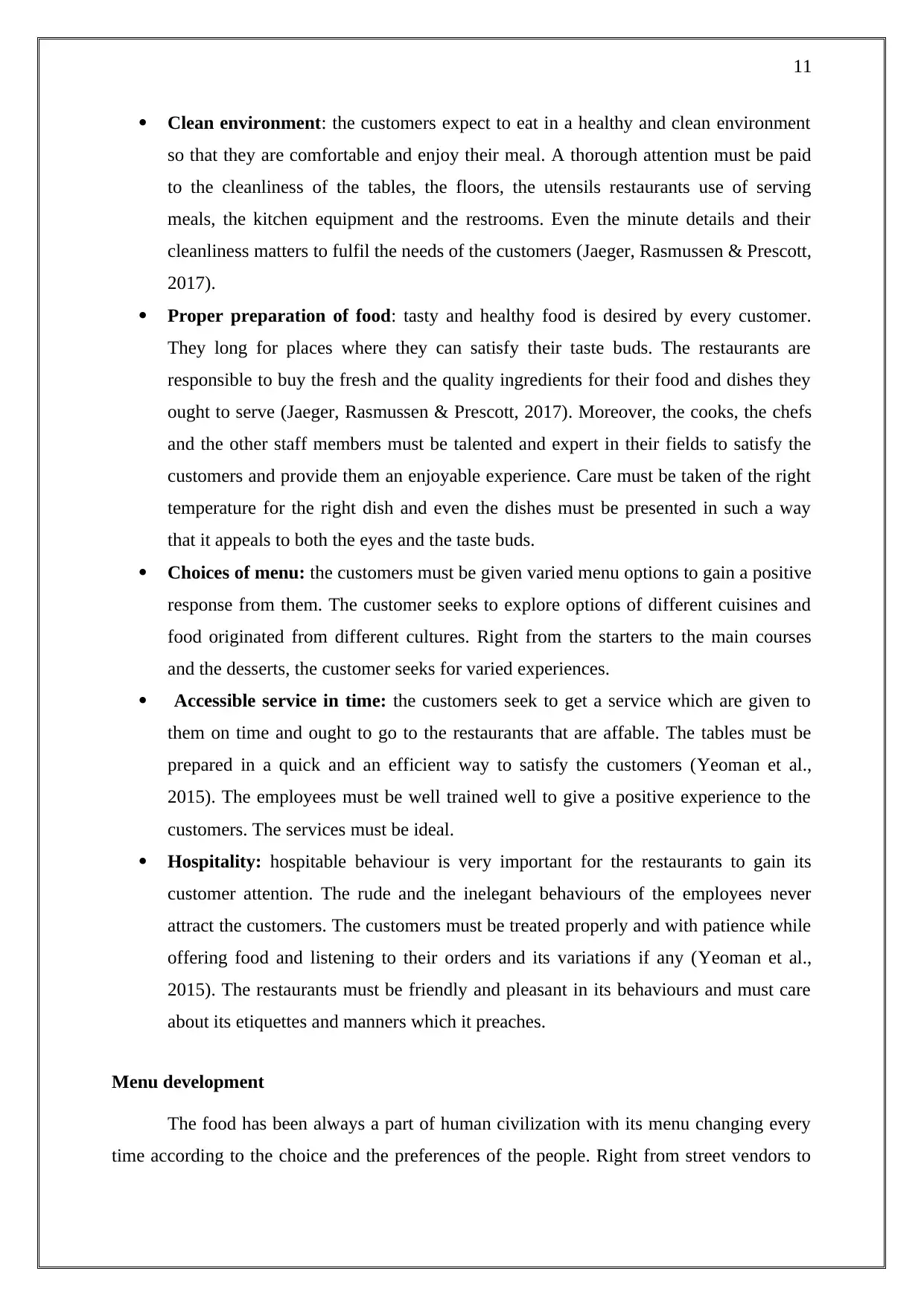
11
Clean environment: the customers expect to eat in a healthy and clean environment
so that they are comfortable and enjoy their meal. A thorough attention must be paid
to the cleanliness of the tables, the floors, the utensils restaurants use of serving
meals, the kitchen equipment and the restrooms. Even the minute details and their
cleanliness matters to fulfil the needs of the customers (Jaeger, Rasmussen & Prescott,
2017).
Proper preparation of food: tasty and healthy food is desired by every customer.
They long for places where they can satisfy their taste buds. The restaurants are
responsible to buy the fresh and the quality ingredients for their food and dishes they
ought to serve (Jaeger, Rasmussen & Prescott, 2017). Moreover, the cooks, the chefs
and the other staff members must be talented and expert in their fields to satisfy the
customers and provide them an enjoyable experience. Care must be taken of the right
temperature for the right dish and even the dishes must be presented in such a way
that it appeals to both the eyes and the taste buds.
Choices of menu: the customers must be given varied menu options to gain a positive
response from them. The customer seeks to explore options of different cuisines and
food originated from different cultures. Right from the starters to the main courses
and the desserts, the customer seeks for varied experiences.
Accessible service in time: the customers seek to get a service which are given to
them on time and ought to go to the restaurants that are affable. The tables must be
prepared in a quick and an efficient way to satisfy the customers (Yeoman et al.,
2015). The employees must be well trained well to give a positive experience to the
customers. The services must be ideal.
Hospitality: hospitable behaviour is very important for the restaurants to gain its
customer attention. The rude and the inelegant behaviours of the employees never
attract the customers. The customers must be treated properly and with patience while
offering food and listening to their orders and its variations if any (Yeoman et al.,
2015). The restaurants must be friendly and pleasant in its behaviours and must care
about its etiquettes and manners which it preaches.
Menu development
The food has been always a part of human civilization with its menu changing every
time according to the choice and the preferences of the people. Right from street vendors to
Clean environment: the customers expect to eat in a healthy and clean environment
so that they are comfortable and enjoy their meal. A thorough attention must be paid
to the cleanliness of the tables, the floors, the utensils restaurants use of serving
meals, the kitchen equipment and the restrooms. Even the minute details and their
cleanliness matters to fulfil the needs of the customers (Jaeger, Rasmussen & Prescott,
2017).
Proper preparation of food: tasty and healthy food is desired by every customer.
They long for places where they can satisfy their taste buds. The restaurants are
responsible to buy the fresh and the quality ingredients for their food and dishes they
ought to serve (Jaeger, Rasmussen & Prescott, 2017). Moreover, the cooks, the chefs
and the other staff members must be talented and expert in their fields to satisfy the
customers and provide them an enjoyable experience. Care must be taken of the right
temperature for the right dish and even the dishes must be presented in such a way
that it appeals to both the eyes and the taste buds.
Choices of menu: the customers must be given varied menu options to gain a positive
response from them. The customer seeks to explore options of different cuisines and
food originated from different cultures. Right from the starters to the main courses
and the desserts, the customer seeks for varied experiences.
Accessible service in time: the customers seek to get a service which are given to
them on time and ought to go to the restaurants that are affable. The tables must be
prepared in a quick and an efficient way to satisfy the customers (Yeoman et al.,
2015). The employees must be well trained well to give a positive experience to the
customers. The services must be ideal.
Hospitality: hospitable behaviour is very important for the restaurants to gain its
customer attention. The rude and the inelegant behaviours of the employees never
attract the customers. The customers must be treated properly and with patience while
offering food and listening to their orders and its variations if any (Yeoman et al.,
2015). The restaurants must be friendly and pleasant in its behaviours and must care
about its etiquettes and manners which it preaches.
Menu development
The food has been always a part of human civilization with its menu changing every
time according to the choice and the preferences of the people. Right from street vendors to
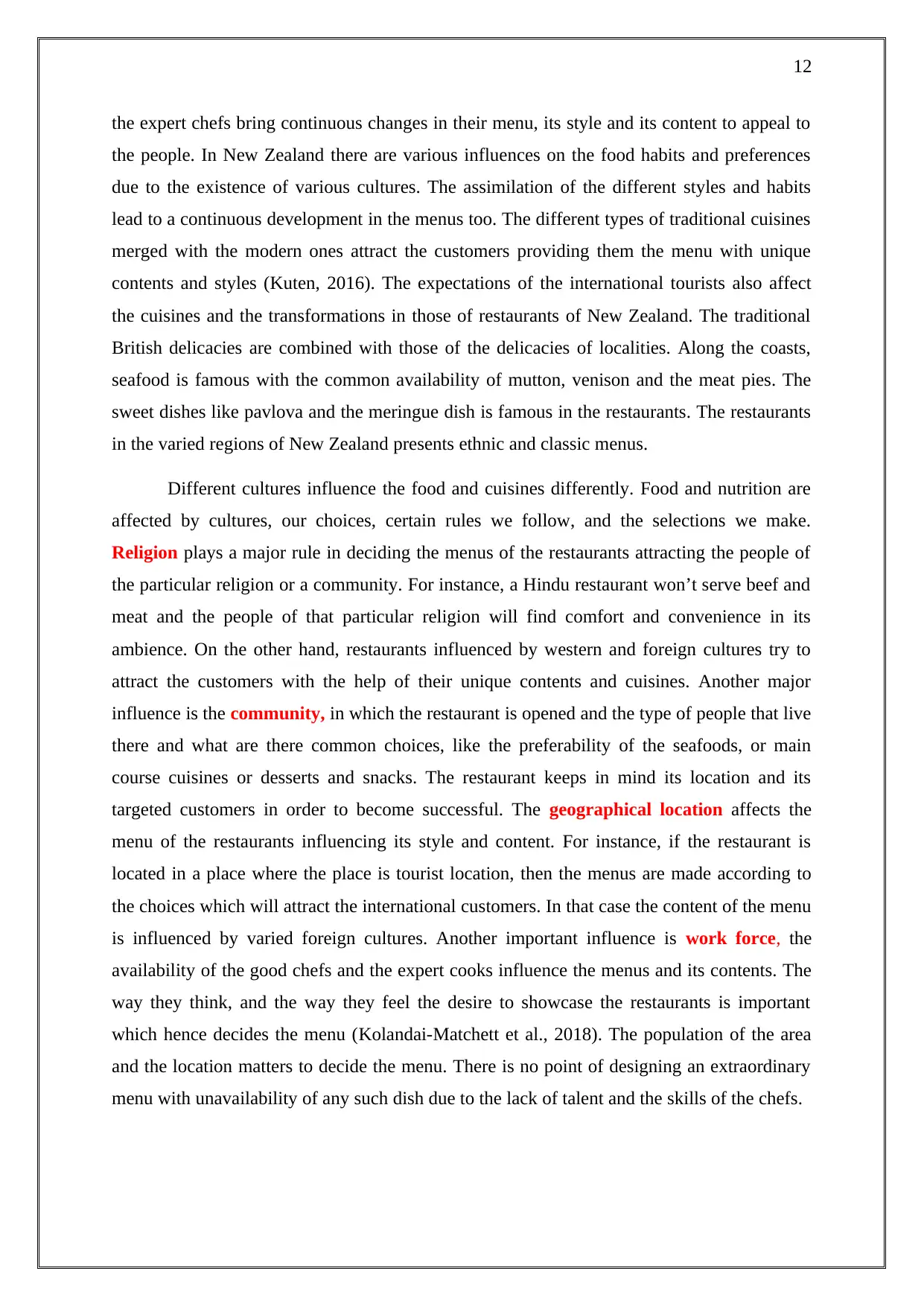
12
the expert chefs bring continuous changes in their menu, its style and its content to appeal to
the people. In New Zealand there are various influences on the food habits and preferences
due to the existence of various cultures. The assimilation of the different styles and habits
lead to a continuous development in the menus too. The different types of traditional cuisines
merged with the modern ones attract the customers providing them the menu with unique
contents and styles (Kuten, 2016). The expectations of the international tourists also affect
the cuisines and the transformations in those of restaurants of New Zealand. The traditional
British delicacies are combined with those of the delicacies of localities. Along the coasts,
seafood is famous with the common availability of mutton, venison and the meat pies. The
sweet dishes like pavlova and the meringue dish is famous in the restaurants. The restaurants
in the varied regions of New Zealand presents ethnic and classic menus.
Different cultures influence the food and cuisines differently. Food and nutrition are
affected by cultures, our choices, certain rules we follow, and the selections we make.
Religion plays a major rule in deciding the menus of the restaurants attracting the people of
the particular religion or a community. For instance, a Hindu restaurant won’t serve beef and
meat and the people of that particular religion will find comfort and convenience in its
ambience. On the other hand, restaurants influenced by western and foreign cultures try to
attract the customers with the help of their unique contents and cuisines. Another major
influence is the community, in which the restaurant is opened and the type of people that live
there and what are there common choices, like the preferability of the seafoods, or main
course cuisines or desserts and snacks. The restaurant keeps in mind its location and its
targeted customers in order to become successful. The geographical location affects the
menu of the restaurants influencing its style and content. For instance, if the restaurant is
located in a place where the place is tourist location, then the menus are made according to
the choices which will attract the international customers. In that case the content of the menu
is influenced by varied foreign cultures. Another important influence is work force, the
availability of the good chefs and the expert cooks influence the menus and its contents. The
way they think, and the way they feel the desire to showcase the restaurants is important
which hence decides the menu (Kolandai-Matchett et al., 2018). The population of the area
and the location matters to decide the menu. There is no point of designing an extraordinary
menu with unavailability of any such dish due to the lack of talent and the skills of the chefs.
the expert chefs bring continuous changes in their menu, its style and its content to appeal to
the people. In New Zealand there are various influences on the food habits and preferences
due to the existence of various cultures. The assimilation of the different styles and habits
lead to a continuous development in the menus too. The different types of traditional cuisines
merged with the modern ones attract the customers providing them the menu with unique
contents and styles (Kuten, 2016). The expectations of the international tourists also affect
the cuisines and the transformations in those of restaurants of New Zealand. The traditional
British delicacies are combined with those of the delicacies of localities. Along the coasts,
seafood is famous with the common availability of mutton, venison and the meat pies. The
sweet dishes like pavlova and the meringue dish is famous in the restaurants. The restaurants
in the varied regions of New Zealand presents ethnic and classic menus.
Different cultures influence the food and cuisines differently. Food and nutrition are
affected by cultures, our choices, certain rules we follow, and the selections we make.
Religion plays a major rule in deciding the menus of the restaurants attracting the people of
the particular religion or a community. For instance, a Hindu restaurant won’t serve beef and
meat and the people of that particular religion will find comfort and convenience in its
ambience. On the other hand, restaurants influenced by western and foreign cultures try to
attract the customers with the help of their unique contents and cuisines. Another major
influence is the community, in which the restaurant is opened and the type of people that live
there and what are there common choices, like the preferability of the seafoods, or main
course cuisines or desserts and snacks. The restaurant keeps in mind its location and its
targeted customers in order to become successful. The geographical location affects the
menu of the restaurants influencing its style and content. For instance, if the restaurant is
located in a place where the place is tourist location, then the menus are made according to
the choices which will attract the international customers. In that case the content of the menu
is influenced by varied foreign cultures. Another important influence is work force, the
availability of the good chefs and the expert cooks influence the menus and its contents. The
way they think, and the way they feel the desire to showcase the restaurants is important
which hence decides the menu (Kolandai-Matchett et al., 2018). The population of the area
and the location matters to decide the menu. There is no point of designing an extraordinary
menu with unavailability of any such dish due to the lack of talent and the skills of the chefs.
⊘ This is a preview!⊘
Do you want full access?
Subscribe today to unlock all pages.

Trusted by 1+ million students worldwide
1 out of 16
Related Documents
Your All-in-One AI-Powered Toolkit for Academic Success.
+13062052269
info@desklib.com
Available 24*7 on WhatsApp / Email
![[object Object]](/_next/static/media/star-bottom.7253800d.svg)
Unlock your academic potential
Copyright © 2020–2025 A2Z Services. All Rights Reserved. Developed and managed by ZUCOL.





